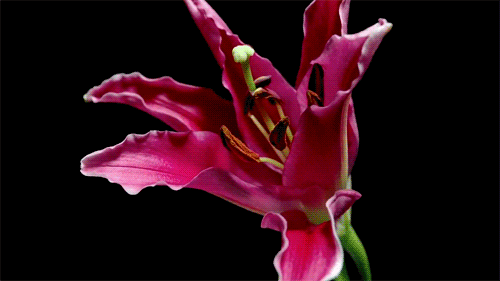Lilium (members of which are true lilies) is a genus of herbaceous flowering plants growing from bulbs, all with large prominent flowers. Lilies are a group of flowering plants which are important in culture and literature in much of the world. Most species are native to the temperate northern hemisphere, though their range extends into the northern subtropics. Many other plants have “lily” in their common name but are not related to “true” lilies.
Many species are widely grown in the garden in temperate and sub-tropical regions. They may also be grown as potted plants. Numerous ornamental hybrids have been developed. They can be used in herbaceous borders, woodland and shrub plantings, and as patio plants.
Lilies are usually planted as bulbs in the dormant season. They are best planted in a south-facing (northern hemisphere), slightly sloping aspect, in sun or part shade, at a depth 2½ times the height of the bulb (except Lilium candidum which should be planted at the surface). Most prefer a porous, loamy soil, and good drainage is essential. Most species bloom in July or August (northern hemisphere).
The flowering periods of certain lily species begin in late spring, while others bloom in late summer or early autumn. They have contractile roots which pull the plant down to the correct depth, therefore it is better to plant them too shallowly than too deep.
A soil pH of around 6.5 is generally safe. The soil should be well-drained, and plants must be kept watered during the growing season. Some plants have strong wiry stems, but those with heavy flower heads may need staking.
Health Benefits and Therapeutic Uses
- One of the main health benefits of the lily flower is that it helps regulating the heart rate thereby allowing the heart to function more efficiently and regularly. The lily flower has many therapeutic uses as it minimizes the irritability of the myocardium without actually resulting in an increase in the oxygen that is required to function by the heart muscle.
- The health benefits of the lily for the heart are well known on account of the presence of the active cardiac glycosides as well as the flavonoids which tend to stimulate the arteries and cause them to dilate.
- Another one of the therapeutic uses of the lily flower is in the case of treating burns and preventing the formation of scar tissue. In this herbal remedy, the roots of the lily flower are used to prepare an ointment which is then applied on the burnt area.
- The therapeutic uses of the lily flower also include it being used in case of weak contractions at the time of childbirth. The lily flower is also used for herbal remedies for medical conditions such as leprosy , conjunctivitis, strokes, angina and so on.
- Another one of the medicinal uses of the lily flower is that the dried flowers are used as a very effective laxative or diuretic . Additionally , the roots and the flowers of the lilies are also used to treat spider bites.
- In some parts of the world , roots of the wood lily variety of the flower are consumed as medicinal teas to treat coughs, fevers, stomach disorders as well as for open sores, wounds and to wash bruises that may have swollen .
- The fresh or dried bulbs of the lily flower are also known to be very effective in treating ulcers and inflammations on account of their astringent and soothing properties. In fact the lily flower is also applied on hard tumors as it is known to soften them immediately.
- Another one of the health benefits and therapeutic uses of the lily flower include the juice of the fresh bulbs of the lily flower being used to cure dropsy naturally.
- The extract of the lily flower is also used in various cosmetics as cure for cuperosis.
Other Uses
The essential oil of the lily flower is used in aromatherapy to treat individuals suffering from depression as it tends to help in creating a feeling of modesty, happiness and a sense of security as well. In fact the essential oil of the lily flower is also an important ingredient in the perfume industry.
Other uses of the lily flower also include the stems of the lily flower being used in Asian cooking as they are sweet, chewy and have a mild vegetable flavor that is similar to that of the lettuce, asparagus or zucchini. In fact the Japanese cuisine is also known to use slices of the sugary sweet and pulpy bulb of the lily flower in many of their dishes.











